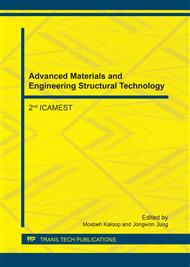[1]
X. Kang, J. Wang, H. Wu, J. Liu, I. A. Aksay, Y. Lin, A graphene-based electrochemical sensor for sensitive detection of paracetamol, Talanta, 81(3) (2010) 754–759.
DOI: 10.1016/j.talanta.2010.01.009
Google Scholar
[2]
Z. Yang, Z. Ye, B. Zhao, X. Zong, P. Wang, A rapid response time and highly sensitive amperometric glucose biosensor based on ZnO nanorod via citric acid-assisted annealing route, Phys. E Low-dimensional Syst. Nanostruct. 42(6) (2010) 1830-1833.
DOI: 10.1016/j.physe.2010.02.001
Google Scholar
[3]
K. S. Novoselov, A. K. Geim, S. V. Morozov, D. Jiang, Y. Zhang, S. V. Dubonos, I. V. Grigorieva, A. A. Firsov, Electric Field Effect in Atomically Thin Carbon Films, Science, 306 (2004) 666.
DOI: 10.1126/science.1102896
Google Scholar
[4]
K. H. Kim, H. J. Park, B. C. Woo, K. J. Kim, G. T. Kim, W. S. Yun, Electric Property Evolution of Structurally Defected Multilayer Graphene, Nano Lett, 8 (2008) 3092–3096.
DOI: 10.1021/nl8010337
Google Scholar
[5]
M. Segal, Selling graphene by the ton, Nat. Nanotechnol. 4 (2009) 612–614.
Google Scholar
[6]
N. Ruecha, R. Rangkupan, N. Rodthongkum, O. Chailapakul, Novel paper-based cholesterol biosensor using graphene/polyvinylpyrrolidone/polyaniline nanocomposite, Biosens. Bioelectron, 52 (2014) 13–19.
DOI: 10.1016/j.bios.2013.08.018
Google Scholar
[7]
G. G. Wallace, R. B. Kaner, M. Muller, S. Gilje, D. Li, D. Li, Processable aqueous dispersions of graphene nanosheets Publication Details Processable aqueous dispersions of graphene nanosheets, Nat. Nanotechnol, 3(2) (2008) 101–105.
DOI: 10.1038/nnano.2007.451
Google Scholar
[8]
M. J. McAllister, J. L. Li, D. H. Adamson, H. C. Schniepp, A. A. Abdala, J. Liu, M. Herrera-Alonso, D. L. Milius, R. Car, A. Robert K. Prud'homme, Ilhan A. Aksay, Single Sheet Functionalized Graphene by Oxidation and Thermal Expansion of Graphite, Chem. Mater, 19(18) (2007).
DOI: 10.1021/cm0630800
Google Scholar
[9]
J. I. Paredes, S. Villar-Rodil, A. Martínez-Alonso, J. M. D. Tascón, Graphene Oxide Dispersions in Organic Solvents, Langmuir, 24(19) (2008) 10560–10564.
DOI: 10.1021/la801744a
Google Scholar
[10]
Y. Zou, X. Wang, Y. Ai, Y. Liu, J. Li, Y. Ji, X. Wang, Coagulation Behavior of Graphene Oxide on Nanocrystallined Mg/Al Layered Double Hydroxides: Batch Experimental and Theoretical Calculation Study, Environ. Sci. Technol, 50(7) (2016).
DOI: 10.1021/acs.est.6b00255
Google Scholar
[11]
D. W. Boukhvalov, M. I. Katsnelson, A. I. Lichtenstein, Hydrogen on graphene: Electronic structure, total energy, structural distortions and magnetism from first-principles calculations, Phys. Rev. B, 77(3) (2008) 35427.
DOI: 10.1103/physrevb.77.035427
Google Scholar
[12]
L. Zhu, L. Luo, Z. Wang, DNA electrochemical biosensor based on thionine-graphene nanocomposite, Biosens. Bioelectron, 35(1) (2012) 507–511.
DOI: 10.1016/j.bios.2012.03.026
Google Scholar
[13]
J. R. Anusha, C. J. Raj, B. B. Cho, A. T. Fleming, K. H. Yu, B. C. Kim, Amperometric glucose biosensor based on glucose oxidase immobilized over chitosan nanoparticles from gladius of Uroteuthis duvauceli, Sens. Actuat. B Chem. 215 (2015).
DOI: 10.1016/j.snb.2015.03.110
Google Scholar
[14]
S. T. Yang, Y. Chang, H. Wang, G. Liu, S. Chen, Y. Wang, Y. Liu, A. Cao, Folding/aggregation of graphene oxide and its application in Cu2+ removal, J. Coll. Interf. Sci. 351(1) (2010) 122–127.
DOI: 10.1016/j.jcis.2010.07.042
Google Scholar
[15]
N. C. D. Nath, S. Sarker, M. M. Rahman, H. J. Lee, Y. J. Kim, J. J. Lee, A facile template-free chemical synthesis of poly(thionine) nanowires, Chem. Phys. Lett. 559 (2013) 56–60.
DOI: 10.1016/j.cplett.2012.12.047
Google Scholar
[16]
J. Ciriza, B. S. L. del, M. Virumbrales-Muñoz, I. Ochoa, L. Fernandez, G. Orive, M. Hernández, J. Pedraz, Graphene Oxide Increases the Viability of C2C12 Myoblasts Microencapsulated in Alginate, Int. J. Pharm, 493(1-2) (2015) 260-270.
DOI: 10.1016/j.ijpharm.2015.07.062
Google Scholar
[17]
J. D. Patel, F. Mighri, A. Ajji, S. Elkoun, Room Temperature Synthesis of Aminocaproic Acid-Capped Lead Sulphide Nanoparticles, Mater. Sci. Appl. 3(2) (2012) 125–130.
DOI: 10.4236/msa.2012.32020
Google Scholar
[18]
G. Wang, X. Shen, B. Wang, J. Yao, J. Park, Synthesis and characterisation of hydrophilic and organophilic graphene nanosheets, Carbon N. Y, 47(5) (2009) 1359–1364.
DOI: 10.1016/j.carbon.2009.01.027
Google Scholar


